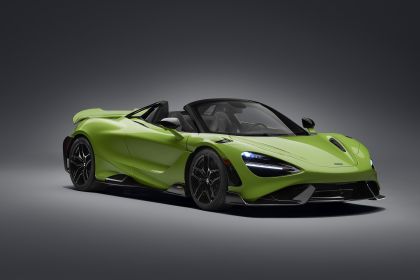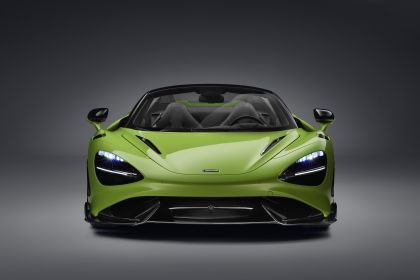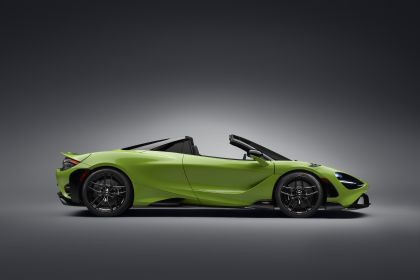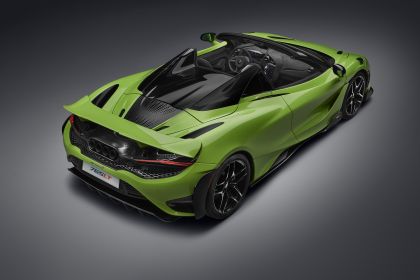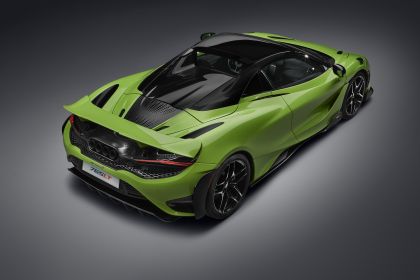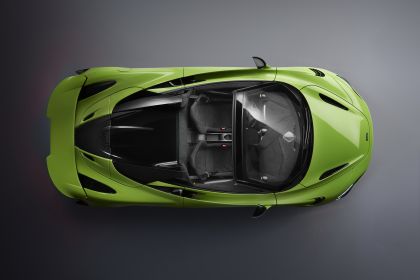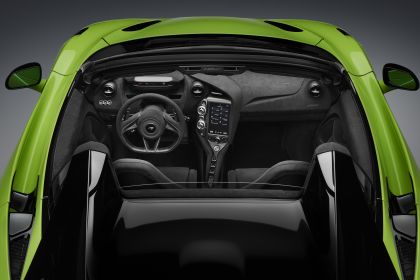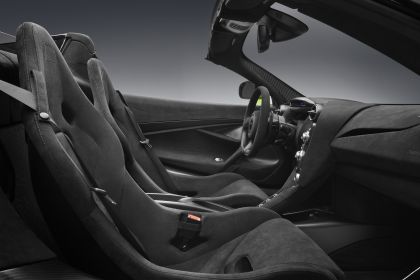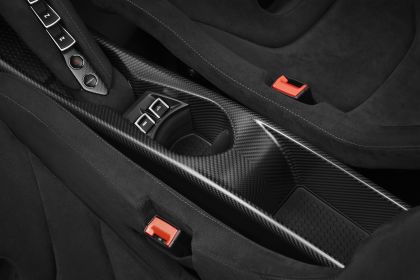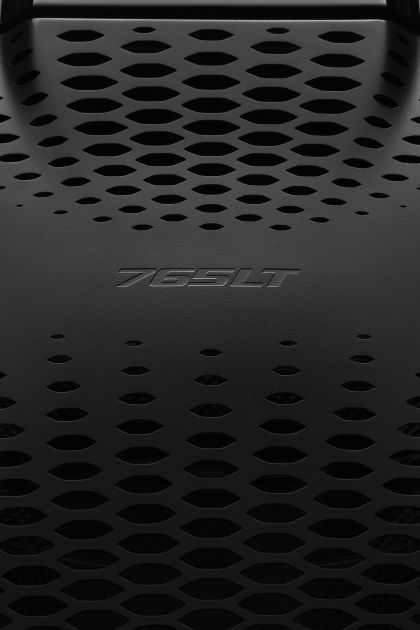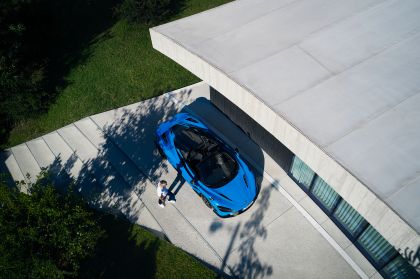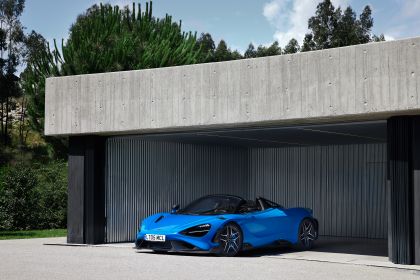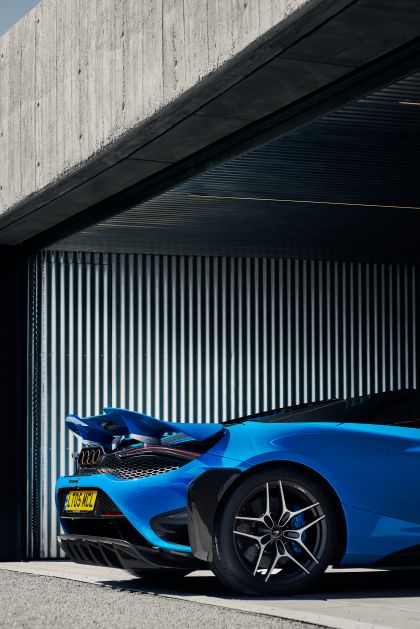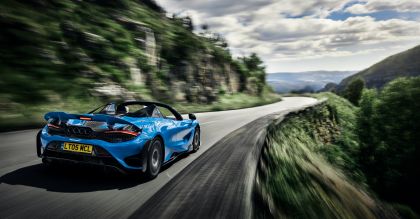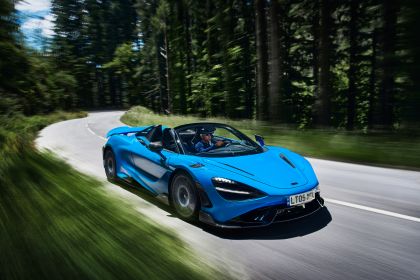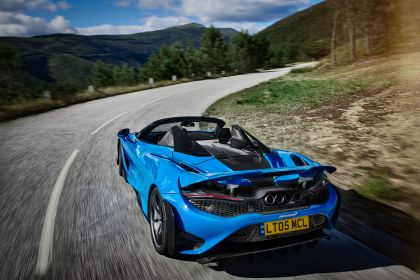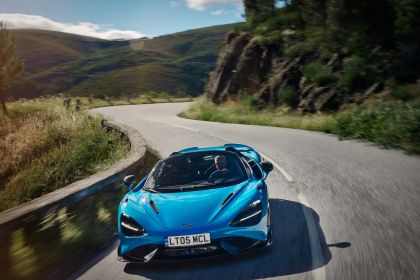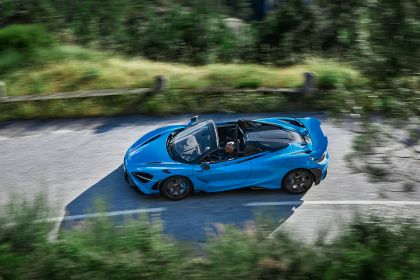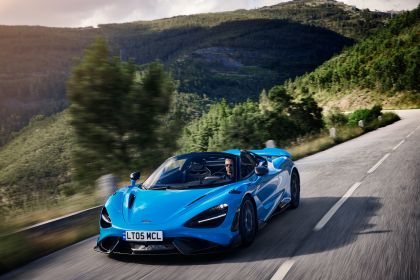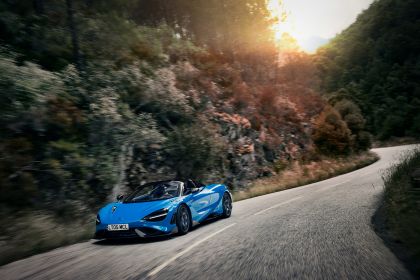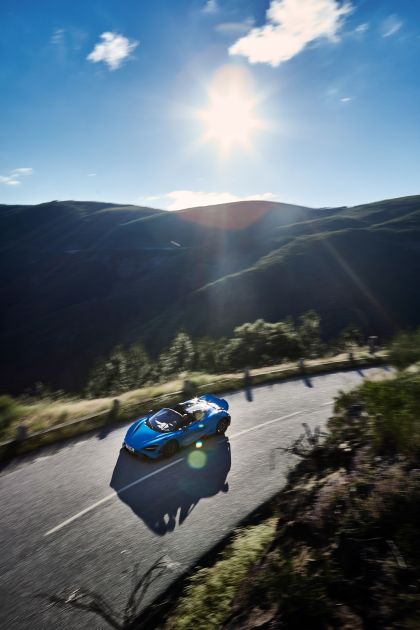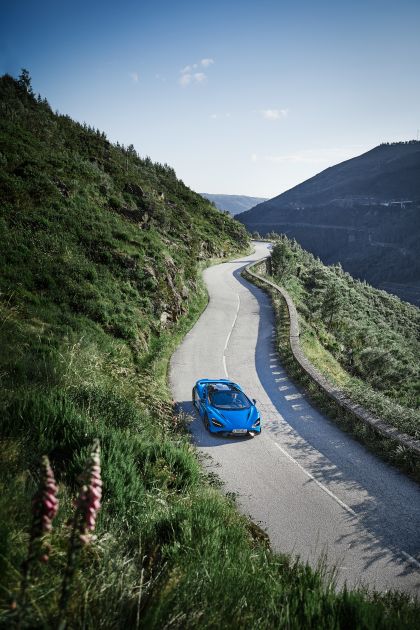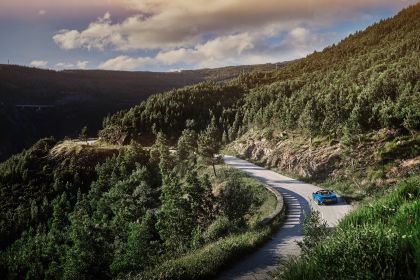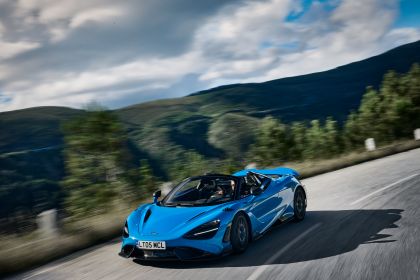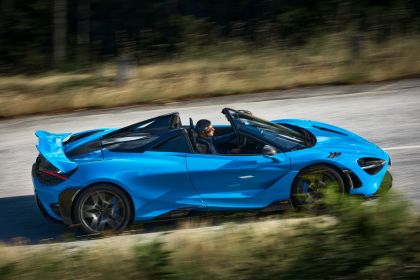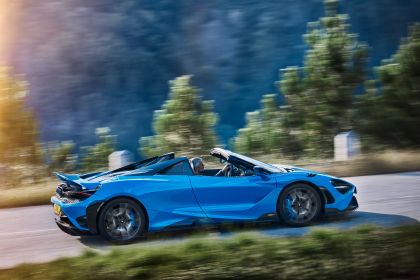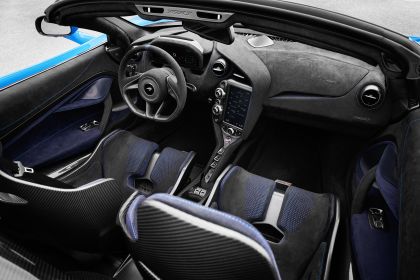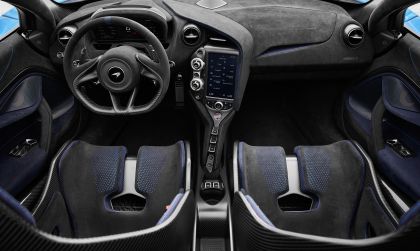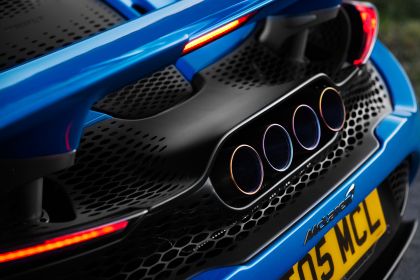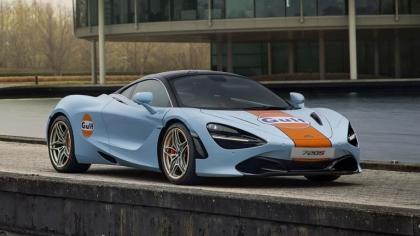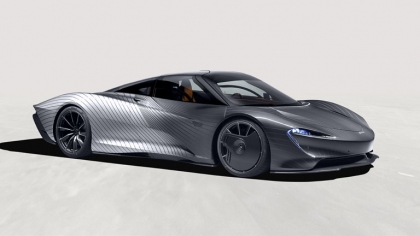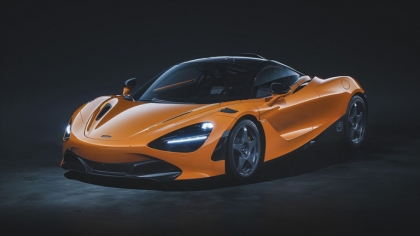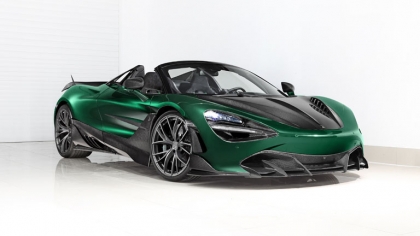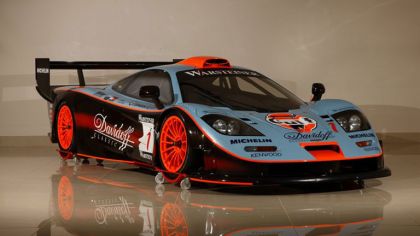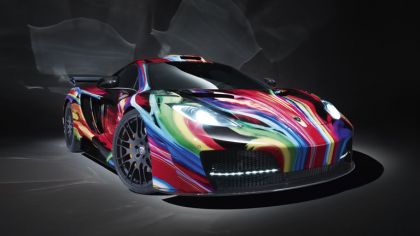- Limited-volume 765LT Spider revealed; available to order now
- Exclusive and highly collectible: just 765 will be built to customer order – the same individually numbered total as the sold-out coupe
- New convertible LT delivers another dimension of ‘Longtail’ driver engagement
- Electrically operated, one-piece carbon fibre Retractable Hard Top (RHT) lowers or raises in just 11 seconds, at speeds of up to 50km/h (31mph), to enhance driving experience
- Powered rear window allows searing ‘LT soundtrack’ from quad-exit, full titanium exhaust system to be enjoyed to the full, even with the roof in place
- 765PS and 800Nm from 4.0-litre twin-turbocharged McLaren V8 enables 0-60mph in 2.7 seconds, 0-100km/h (62mph) in 2.8 seconds and 0-200km/h (124mph) in 7.2 seconds
- The fastest accelerating LT Spider ever – 15% quicker in-gear acceleration than 720S – with transmission gearing optimised for driver engagement
- Even greater focus on minimising weight – 80kg lighter than 720S Spider at 1,388kg (DIN weight) and just 49kg heavier than 765LT coupe
- Convertible class-leading power-to-weight ratio of 598PS-per-tonne at lightest dry weight
- High-performance lightweight materials feature throughout, with advanced carbon fibre technologies used for body components
- Specific weight-saving components include titanium exhaust system (saving 40% over steel equivalent), Formula 1-grade transmission materials and thinner glass
- Same carbon fibre aerodynamic package as the coupe – front splitter and front floor, side skirts, front and rear bumper and rear diffuser – but with active rear wing calibrated for roof up/roof down positions
- Class-leading aerodynamic downforce – 25% more than 720S Spider
- Enhanced chassis dynamics, with bespoke LT springs and dampers, increased front track width, lower front ride height and unique software programming for linked-hydraulic Proactive Chassis Control II suspension
- Standard-fit 10-spoke Ultra-Lightweight forged alloy wheels and bespoke P Zero™ Trofeo R tyres developed by McLaren technical partner, Pirelli
- Motorsport-inspired interior with carbon fibre racing seats, carbon fibre centre tunnel, exposed carbon fibre floor and lightweight Alcantara® throughout
- Air-conditioning and audio system not included as standard to save weight, but can be specified at no additional cost
- MSO Clubsport Pack and MSO LT Black Pack available, plus multiple individual MSO options
Renowned worldwide for the exclusive, luxury, high-performance supercars on which it has built its reputation over the past decade, McLaren Automotive today reveals another landmark model: the 765LT Spider.
Complementing the 765LT ‘Longtail’ coupe unveiled last year – all of which are sold – the new Spider is McLaren’s most powerful-ever convertible supercar and brings highest-ever levels of driver engagement to the McLaren LT experience. Engineered in addition with the other core attributes intrinsic to any McLaren Longtail – minimised weight, track-focused dynamics and optimised aerodynamics – the 765LT Spider has all of the class-leading abilities of the coupe and also meets the LT demand for exclusivity: just 765 cars will be available globally for customer order.
Carrying over the coupe’s dynamic and aerodynamic DNA with no structural compromise and only a minimal 49kg weight increase – primarily from the retractable hard top and accompanying operating mechanism – the 765LT Spider weighs in at just 1,388kg (DIN weight), which is 80kg lighter than a 720S Spider and circa 100kg lighter than its closest comparable competitor.
The electrically operated, one-piece carbon fibre Retractable Hard Top (RHT) enables open-top motoring in just 11 seconds and operates at speeds of up to 50km/h, bringing the dramatic soundtrack of the quad-exit titanium exhaust system into the cabin to take driver engagement into another dimension.
“As we continue to build the LT sub-brand with the introduction of the new 765LT Spider, it’s clear that our customers are increasingly attracted to the Longtail supercar proposition of exhilarating, extreme performance and limited availability. With all 765 examples of the 765LT coupe sold, it’s no surprise that as we publicly announce our new LT Spider, production capacity for 2021 is already filled.”
Mike Flewitt, Chief Executive Officer, McLaren Automotive
The immense performance and dynamic prowess of the new Spider – already proven in the 765LT coupe – are enhanced by three compelling factors: the stability of its MonoCage II-S structure, the game-changing design of its one-piece Retractable Hard Top roof, and the ongoing determination of McLaren engineers to pursue the company’s philosophy of super-lightweight engineering.
The Spider version of the carbon fibre MonoCage II – designated MonoCage II-S – was developed alongside the coupe monocoque and shares most of its structural elements, including the windscreen surround. Such is the strength and stiffness of the structure that no additional bracing is required over the coupe – another weight-optimising factor. At the rear of the car, carbon fibre structural supports are fully bonded into the chassis to provide rollover protection.
The convertible roof design plays an integral role in the structure, featuring a carbon fibre frame within the Retractable Hard Top panel and creating a full carbon fibre shell when closed. There are also additional comfort benefits for occupants – because it is a single-piece panel with no central seal, headroom is improved, while the extended length of the roof panel allows the tops of the A-pillars to be further forward, enhancing the sense of space and easing ingress and egress.
Like every LT, the new Spider is designed to excel on track, however the extra dimension of theatre and drama offered by the convertible roof also makes it an even more immersive and compelling car to drive on the road. With the same highly evolved aerodynamic package as the coupe – although with active rear wing calibration revised to reflect whether the roof is up or down and a recalibration of the dampers to account for the minor increase in weight – the Spider matches the coupe’s outstanding aero performance in every respect, with class-leading downforce 25% greater than that of a 720S Spider.
Performance is ferocious, the 4.0-litre twin-turbocharged V8 engine producing 765PS – giving the 765LT Spider a best-in-class power-to-weight ratio of 598PS-per-tonne at lightest dry weight – and 800Nm of torque. Transmission gear ratios have been revised for even greater engagement and performance; in-gear acceleration is 15% quicker than a 720S Spider, helping the new Longtail to achieve the fastest lap times ever posted by a convertible LT model.
The 0-100km/h time often seen as a benchmark figure is 2.8 seconds (0-60mph is 2.7 seconds), with 0-200km/h (124mph) taking 7.2 seconds. The new LT Spider takes 10.0 seconds to cover 400m (¼ mile) from standstill and the car’s maximum speed is 330km/h (205mph).
“A McLaren ‘Longtail’ is engineered to deliver not only incredible performance but also the highest levels of driver engagement. The 765LT coupe set new benchmarks in maximising a driver’s connection with the car and the Spider builds on this, adding the additional engagement factor of open-air driving to give direct access to the scintillating sound of the titanium exhaust – a pleasure that thanks to the electrically operated rear window can also be enjoyed with the retractable roof in place.”
Jamie Corstorphine, Director of Product Strategy, McLaren Automotive
The most powerful McLaren convertible ever and the latest and most engaging addition to the brand’s Longtail lineage can be ordered now from McLaren retailers. Pricing is from £310, 500* and availability is limited to just 765 cars for customer order worldwide, with 2021 production already all sold.
McLaren 765LT Spider in detail
Maximising the McLaren LT experience
The Longtail name became legend nearly a quarter of a century ago, when an extreme lightweight version of the Le Mans-conquering McLaren F1 GTR race car, wearing a stretched body, swept all before it in the 1997 FIA GT Championship. The principles behind that car – ultra-low weight, enhanced aerodynamics, extreme performance and absolute driver engagement – were revisited in 2015 when McLaren introduced the 675LT.
The new 765LT Spider, like its predecessors, stays true to those Longtail principles, placing the driver at the very centre of the sensory, dynamic and – especially in this case – aural experience, the triple-patented Retractable Hard Top roof taking driver engagement to an ever-higher level.
“Lowering the convertible roof of the 765LT Spider opens up another level of driver engagement. The coupe is impressive in its own right, but when you lower the roof of the Spider, there is a step-change in character – almost a theatrical element, like experiencing a live orchestra from right in front of the stage.”
Ian Howshall, Global Product Manager, McLaren Automotive
The Retractable Hard-Top is constructed using a single carbon fibre frame featuring a high-density, noise-reducing foam core between the panel and the internal headlining. This removes mass from the upper section of the car as well as reducing the volume of unwanted noise inside the cabin. It also creates more headroom for occupants by removing the central seal that previously ran side-to-side across the roof panel.
The roof mechanism of the 765LT Spider is among the world’s quickest and quietest Occupants will experience a sound no louder than 50 dBA during operation, with a peak of 60 dBA during the latching process – twice as quiet as the roof of the 675LT Spider, the first convertible LT supercar. Fully electrically controlled, the roof can be opened or closed in just 11 seconds, at speeds up to 50km/h. The system is powered by eight electrical motors – two to fold the roof panel, two to raise and lower the tonneau cover and two to control the dynamic flaps which deploy on the tonneau buttresses when the roof is open.
The rear window, which can be lowered even when the roof is up to intensify the quadrophonic exhaust note, has its own motor, as does the RHT latching mechanism. All these motors are optimised to work in parallel, allowing the roof to begin to move before the tonneau has completely opened, which saves time. The 675LT Spider’s roof – which took 17 seconds and operated at speeds of up to 30km/h – was controlled by a hydraulic pump, meaning each step of the process had to happen sequentially.
The roof panel is also significantly longer than its 675LT predecessor, allowing the tops of the A-pillars to be moved forward by 80mm, increasing the size of the door opening for ease of access. This was enabled by the incredibly strong, stiff and stable MonoCage II-S chassis. Because the upper section as well as the lower structure is constructed from carbon fibre, the Spider’s structure delivers a full safety cage without the need for any reinforcement of the windscreen surround. This, plus the fact that no extra bracing of the tub is required, helps reduce the weight difference between coupe and Spider to a minimal 49kg.
The MonoCage II-S differs from the coupe’s MonoCage II only at the rear, where a carbon fibre upper structure is engineered around the engine bay, and two fixed carbon fibre structural supports are bonded into the chassis to provide rollover protection. The upper structure sits close to the air charge coolers and intake plenum, helping to maximise luggage space and lower the height of the tonneau cover – factors which in turn improve both aerodynamic performance and over-the-shoulder visibility.
Saving weight, the McLaren way
Every McLaren is designed to a philosophy of super-lightweight engineering, to the point where further reducing weight is extremely challenging. The 720S Spider from which the 765LT Spider is developed weighs just 1,468kg and boasts a better power-to-weight ratio than any of its competitors. But the Longtail ethos has always demanded relentless pursuit of lowering weight: the original F1 GTR was unthinkably light for its day, but the F1 GTR Longtail was more than 100kg lighter still. True to the LT bloodline, at 1,388kg (DIN) the new Spider shaves 80kg off the DIN weight of the 720S Spider.
Whether coupe or Spider, weight matters because it lessens inertia, which in turn sharpens response to every driver input to accelerator, brakes or steering. McLaren’s expertise in carbon fibre comes to the fore, not just in the MonoCage chassis but also in many bespoke body panels and components, while other super-lightweight materials such as titanium are also introduced. In addition, powertrain and chassis parts have been reworked and optimised, comfort and convenience features have been deleted and ultra-lightweight seats fitted.
“We’ve kept the weight delta between 765LT coupe and Spider to an absolute minimum. The exacting development of the RHT and the fact the chassis doesn’t need any stiffening ensure that the Spider is in every respect a true driver’s car – extremely track-focused and dynamically the equal of the coupe.”
James Warner, Chief Engineer, McLaren Automotive
The front splitter, new front bumper, lower door blades and side skirts, wraparound rear bumper and active rear wing are all made of carbon fibre and bespoke to the 765LT. The bonnet, front fenders, outer door panels and rear fenders – which are in lightweight aluminium as standard – are also available in body-colour carbon fibre as MSO Defined options. The front fenders reduce weight by a total of 1.2kg, the rear fenders and door panels together by 4.9kg.
The one-piece carbon fibre front floor, constructed at McLaren’s Composites Technology Centre (MCTC) near Sheffield, UK, is notably unique; extremely light and stiff, it not only optimises the aerodynamic performance of the revised underbody – further reducing inertia – but also allows the front end of the Spider to be common with the coupe.
Every component has been assessed with weight-saving opportunities in mind. The windscreen and side windows are thinner and therefore lighter than the 720S; a next-generation lithium-ion battery saves 3.0kg and the full titanium exhaust system weighs just 10.9kg (40% less than a stainless steel system would weigh). Formula 1-spec 20NiCh nickel chrome has been used to form the pinion and crown wheel inside the transmission final drive, while the suspension features lightweight springs assisted by ‘helper’ springs – the use of two springs saving weight compared to a larger dual-rate spring.
A full 22kg has been saved in the development of the LT’s bespoke Ultra-Lightweight forged alloy wheels, each fitted with Pirelli P Zero™ Trofeo R tyres specially developed for the 765LT. Titanium wheel bolts are also standard fit.
In addition to all this, a significant proportion of the 80kg weight saving over the 720S is achieved inside the cockpit. The carbon fibre-shelled race seats fitted as standard are together 18kg lighter than the 720S sports seats. First seen on the McLaren P1™, the seats feature a lightweight Alcantara® covering, which also appears on the steering wheel, dashboard and doors.
The cockpit’s central tunnel is made of carbon fibre just 0.8mm thick, the door pockets are replaced by nets, and carbon fibre has been used for such micro-details as the window switch surrounds, steering wheel clasp and Active Dynamics Panel surround. Further weight is saved by deleting the floor carpet (saving 2.4kg), air-conditioning system (10kg) and audio system (1.5kg) – although the latter two can be specified for fitment at no extra cost.
The weight-saving measures incorporated as standard achieve the 80kg delta to the 720S, but for owners who want to go even further a lightest dry weight of just 1,278kg is possible by fitting optional components such as Super-Lightweight carbon fibre race seats. First developed for the McLaren Senna, these seats are one-third lighter than the standard seat, an innovative double-skin technology meaning each seat shell weighs just 3.35kg.
Power, performance – and absolute driver engagement
That intuitive connection between driver and car is a core strength of all McLarens, but in an LT model it is elevated to new heights. Every element of the 765LT driving experience is enhanced in both Spider and coupe, the two models having been developed alongside each other with the clear strategy of delivering an equally visceral level of engagement.
“We developed the 765LT Spider to be a car without compromise, every bit as exciting and rewarding to drive as the coupe, with all of the connection, closeness and engagement – but with the added benefit of so much more of that amazing LT sound, even closer to the driver. “
James Warner, Chief Engineer, McLaren Automotive
The 765LT Spider features the same twin-turbocharged M840T engine as the coupe, a 4.0-litre V8 with a flat-plane crankshaft, dry sump lubrication, ultra-low-inertia twin-scroll turbochargers and electronically controlled wastegates. The engine also has LT-specific forged aluminium pistons, the McLaren Senna’s three-layer head gasket and ultra-efficient, carbon-coated valve train followers.
Power and torque delivery – 765PS (755bhp) at 7,500rpm and 800Nm (590lb ft) at 5,500rpm – are controlled by an engine management system with bespoke calibration. The benchmark acceleration figures tell their own story: 0-100km/h (0-62mph) in 2.8 seconds (0-60mph in 2.7 seconds), and 0-200km/h (0-124mph) in 7.2 seconds. This extraordinary performance – comparable with that of the coupe – is made even more accessible by gear ratios optimised to deliver acceleration times 15% quicker than those achieved by the 720S, with virtually instant throttle response throughout.
Steering feedback is enhanced by a quicker steering rack ratio and stiffer torsion bar being added to McLaren’s lauded electro-hydraulic steering system. The linked-hydraulic Proactive Control II suspension introduced on 720S benefits from 765LT-specific updates to software – which features revised algorithms derived from those developed for the McLaren Senna and Speedtail programmes – and hardware changes including the new lightweight dual springs. At the front, ride height is 5mm lower and track 6mm wider than on a 720S. All of these measures optimise precision, control, stability and roll stiffness to deliver an even more track-focused driving experience.
The package of aerodynamic measures developed for the 765LT coupe remains virtually unchanged in the Spider, which benefits from the same 25% increase in downforce over the 720S as the coupe. The key aero difference is the calibration of the elongated Longtail active rear wing, the angle of deployment of which is influenced not only by the need for a different setting for driving with the roof lowered, but also by the fact that the Spider’s rear profile differs from that of the coupe.
Pushing the Aero button in the cabin engages ‘Driver Downforce’ which sets the wing angle depending on speed. The angle increases with the roof down to recover the rear downforce lost through the extra disturbance of airflow. For the Spider driver, all of this is happening in the background and the resulting variations are seamless.
To better exploit the huge potential of the 765LT Spider, the driver can adjust transmission and suspension characteristics using the Comfort, Sport and Track mode settings on McLaren’s trademark Active Dynamics Panel. The 765LT’s transmission increases driver control by way of a new function called ‘limit downshift’; previously, a gearshift would be refused by the 7-speed Sequential Shift Gearbox if the shift would over-rev the engine, whereas on the new LT the transmission software acknowledges the shift request and changes gear as soon as engine speed and road speed permit. The process also creates audible drama by momentarily allowing the engine to ‘bounce’ off the rev limiter.
The 765LT’s bespoke brakes, wheels and tyres are also key to enhanced dynamic feedback and driver engagement. Braking performance is simply phenomenal, latest-generation carbon ceramic discs combining with calipers from the McLaren Senna to provide precise pedal feel and astonishing stopping power. The 765LT Spider also features the Formula 1-inspired integrated caliper cooling that debuted on the coupe, reducing brake pad temperatures by up to 50 degrees during track driving and ensuring consistent feel and performance.
More serious track drivers can specify a brake upgrade comprising the McLaren Senna’s 60% stronger carbon ceramic discs that deliver four times the thermal conductivity – and heat management – of conventional carbon ceramic components.
The 765LT Spider runs on 10-spoke Ultra-Lightweight forged alloy wheels, with a unique tyre engineered by McLaren and its technical tyre partner, Pirelli, specifically for this car. The Pirelli Trofeo R tyre is tailored to optimise the 765LT’s revised chassis dynamics and increase cornering speeds, giving the driver maximum feedback from the road or track.
Music to a driver’s ears…
The unique LT soundtrack plays a much more complex part in driver engagement than simply filling the cabin with sound. Engine mount stiffness is increased to aid dynamic performance, and also to transfer and radiate more of the engine’s low-frequency sounds into the cabin, amplifying each change in rpm and allowing the driver to physically experience the engine.
The titanium exhaust system dominates the soundstage as much as it does the rear of the car. The four centrally mounted round exit pipes are meticulously designed, sized, angled and positioned, the pipe diameter increasing exhaust volume and the relative position of each pipe to the others delivering the precise harmonic content required. The resulting high-frequency note that rises with the rev range – a sound so key to the heart of the driving experience that it was established first on an early mule test, even before design and thermal management were addressed – is one of the LT ‘signatures’.
The soundtrack can take on a different character depending on where the 765LT is sold – in EU markets two titanium valves are fitted to the pipes, producing a quieter exhaust note at lower engine speeds and a more engaging tone at higher revs.
Designed to deliver the highest levels of performance
The elongated silhouette which gave the original Longtail its name back in 1997 was created for a very specific purpose, and everything McLaren has designed since then has followed that philosophy of ‘everything for a reason’ and ‘form follows function’. The 765LT Spider is the absolute example of this, with every detail of its highly complex, sculpted shape serving the cause of higher performance.
“A McLaren LT is defined by its rebellious spirit, and a distinctive, striking appearance is an important part of that appeal. The dynamic attributes of a Longtail also demand physical changes; the stretched silhouette that enhances aerodynamic performance and the honed physique that improves downforce and cooling – especially on track – immediately signal that the 765LT Spider is a car that will deliver on the promise of the purest driving thrills.”
Rob Melville, Design Director, McLaren Automotive
The 765LT Spider’s organically honed bodywork incorporates track-focused technical detailing, with Visual Carbon Fibre or Dark Palladium-finished components marking where airflow is entering and exiting the vehicle. This is a harder-edged look than that of the 720S, highlighting how the flow of air is managed to meet the car’s demanding performance targets.
The nose of the 765LT Spider is 48mm longer than that of the 720S and the active rear wing adds 9mm, making the car 57mm longer overall. The front bumper and splitter – the latter now being closer to the ground because the ride height at the front is 5mm lower than that of a 720S – have been moved forward. Rear ride height remains the same, which increases vehicle rake and creates more downforce.
The 765LT may be longer than a 720S, but the bodywork has less physical volume overall, increasing heat evacuation from the engine bay and reducing air pressure within the wheelarches. At the rear, the bumper has been pushed closer to the engineering hard points, exposing the rear tyres, while above it the active rear wing overhangs and curves upwards towards its centre. The active rear wing is as imposing as it is effective: longer than a 720S wing, 60mm higher and with a 20% greater surface area, its elevated position increases downforce even at lower speeds when it isn’t deployed. Because the wing has a minimal effect on drag, the 765LT’s downforce-to-drag ratio (aero efficiency) is also increased over the 720S, again by 20%.
The wing’s importance to the 765LT’s performance cannot be overstated: its role in managing downforce, end-to-end balance and stability, braking and acceleration is absolutely pivotal to the car’s dynamic flow. The Spider does not miss out on any of the hard-won benefits achieved for the coupe – despite the rear profile being slightly more ‘notchback’ in the buttress area, it is able to match the coupe’s balanced aero performance by virtue of the recalibration of the rear wing angles, with a modest adjustment to the damping set-up being the only further change required. The aerodynamic performance allows the front springs to be softer than would be the case if they were solely responsible for maintaining the front ride height, a condition which in turn improves front axle compliance.
Aiding powertrain cooling by drawing hot air out of the engine bay as well as increasing downforce, the wing features a recess in the centre that both improves visibility and protects the carbon fibre from exhaust heat when stationary after extended track running. The wing also deploys as an airbrake under braking from high speed, standing almost vertically – only then do you truly get a sense of its sheer size – and increasing rear downforce by 60%.
The highly complex and completely bespoke design of the front splitter also plays a huge role in the 765LT’s performance. It separates, directs and works the airflow around, over and under the car, cooling the Low Temperature Radiators (LTRs) which sit behind the headlights. The outer edges of the splitter feature distinctive vertical blades which guide airflow around the front wheels and calm the aero wake, working in conjunction with the airflow coming out of the LTR exit vents above. Upturned aero blades sit between the inner surface of the vertical blades and the front bumper, acting as dive planes similar to those on the 720S GT3 race car and track-only McLaren Senna GTR, with air directed up and over them to create more downforce.
The doors of the Spider differ from those of the coupe in that they have no upper carbon fibre frame, are physically smaller and lighter and require only a single hinge (compared to the coupe’s double hinge fitment). When opened, the Spider’s doors extend further than the coupe’s by 120mm each side – the only difference in dimensions between the two models.
The doors employ the double-skin technique used in the legendary McLaren P1™ and further developed to great effect on the 720S. The door blades have been modified to integrate an additional vertical blade that extends from the skirt of the vehicle and controls turbulent air as it exits the front wheelarch, helping to guide it into the expanded intakes ahead of the rear wheelarch. These intakes feed the lower section of the High Temperature Radiators (HTRs), increasing the efficiency of the cooling system.
Step inside the cockpit of the 765LT Spider and you’ll immediately spot the debossed 765LT logo on the facia and the unique numbered dedication plaque, visual clues that you have entered an exclusive space. As befits an LT, the cockpit is forensically focused around the driver, a stirring menu of lightweight features and racing-inspired components blending with generous room, excellent ergonomics and exquisite materials to create a truly unique supercar experience.
The interior differences between coupe and Spider are minimal, the latter’s cabin having an extra element of carbon fibre upper trim which ‘flows’ from interior to exterior. The coupe’s engine window also makes way for the Spider’s folding roof mechanism. There is additional luggage space under the rear tonneau cover, as well as 150 litres of stowage at the front.
Forward visibility is outstanding, thanks to the incredibly slim A-pillars allowed by the carbon fibre MonoCage II-S, while the sense of interior space is enhanced by the bigger, thinner roof panel of the Spider in comparison to the coupe. This sensation can be further heightened by specifying the roof in Electrochromic glass, offering adjustable levels of tinting.
The carbon fibre-shelled race seats, first featured on the McLaren P1™ and subsequently on every LT model, are trimmed in lightweight Alcantara® and provide superb support from an outstanding driving position. The McLaren Senna’s Super-Lightweight double-skinned carbon fibre race seats can be specified as an option.
Key connectivity functions, including McLaren Track Telemetry (MTT), are displayed on the 8-inch, high-resolution Central Infotainment Screen, which works in conjunction with the innovative Folding Driver Display located directly in front of the driver to provide an integrated information platform. Primary functions, such as the Active Dynamics Panel, are located in the driver’s field of view.
Customers who value convenience features above relentless pursuit of weight saving can embrace a portfolio of choices. An audio system is absent from the standard specification – saving 1.5kg – but a lightweight McLaren 4-speaker system can be optioned at no cost, as can Bluetooth telephony, iPod/iPhone integration and audio voice prompts. An upgraded, world-class audio system developed specially for McLaren by Bowers & Wilkins, is also available.
Door stowage pockets and a central tunnel with lockable stowage can be specified as options in lieu of the lightweight nets and carbon fibre central tunnel fitted as standard. A driver-controlled vehicle-lift system that raises the nose of the car when needed to traverse speed bumps or car park ramps is a no-cost option, as is a choice of high-definition reversing camera or enhanced 360-degree 4-camera park assist system featuring ‘bird’s eye’ view. In applicable markets, Homelink® enables the remote opening of up to three electric garage doors or house gates.
A rich array of personalised trim options is available, including unique exterior colours and a range of interior material choices. To showcase the 765LT Spider’s sharply honed dynamic personality, eight ‘By McLaren’ interior colour themes have been designed. The first of these themes introduces a subtle hint of colour throughout the Alcantara® interior, replacing the Carbon Black stitching with McLaren Orange. Three themes go further, introducing an additional Alcantara® colour with a complementary stitch on specific areas – including the seats and doors – on a Carbon Black Alcantara base®: Dove Grey Alcantara® with Situs Grey stitching, Burnt Orange Alcantara® with Carmine stitching and Midnight Blue Alcantara® with Kingfisher Blue stitching. A graphic laser-cut into the seats is included with these themes, respectively allowing a McLaren Orange, Situs Grey, Carmine or Azura Blue secondary colour to become visible, corresponding with the coloured stitching in the cabin.
The remaining four ‘By McLaren’ themes offer a luxurious alternative to Alcantara®, featuring Carbon Black softgrain leather with contrasting stitching in McLaren Orange, Situs Grey, Carmine or Kingfisher Blue. All the ‘By McLaren’ interiors can be specified, at no extra cost, with a 12 o’clock stripe on the Alcantara® steering wheel, in McLaren Orange, Burnt Orange, Blue or Dove Grey.
The Folding Driver Display and Central Infotainment Screen surrounds are both available in carbon fibre to complement the finish of the window switch surrounds, steering wheel clasp and Active Dynamics Panel surround. Further carbon fibre is available from the MSO Defined range, including satin finish visual carbon fibre for the air vents and extended sill trims with unique 765LT branding.
McLaren Special Operations – for those who want more…
Customers who want to access yet another level of individuality can turn to McLaren Special Operations (MSO) for an almost limitless choice of personalisation. This is McLaren’s ‘dream factory’, capable of turning almost every customer vision into reality on their finished car.
“Our mission is to transform cars that are already exclusive into something unique. McLaren Special Operations puts customers at the centre of the creative process, with access to a full range of personalisation choices – from the individual components, performance enhancements and finishes comprising the rich menu of MSO Defined options through to bespoke options and projects that produce one-of-a-kind cars. More than 85% of 765LT coupe customers have engaged with MSO and we are expecting interest from Spider buyers to be higher still.”
Ansar Ali, Managing Director, McLaren Special Operations
There are two MSO Defined packs available for the 765LT Spider – the Clubsport Pack and the LT Black Pack. The MSO Clubsport pack both reduces overall weight and increases circuit performance with a portfolio of lightweight options and performance upgrades. These include McLaren Track Telemetry with three cameras, Super-Lightweight Carbon Fibre Racing Seats and a track brake upgrade featuring carbon ceramic brake discs and bespoke brake pads from the McLaren Senna. The MSO LT Black Pack gives the 765LT Spider even more of a ‘stealth’ look, with external technical components – tonneau, front splitter, rear bumper and diffuser, air intakes and door mirror casings – all finished in Gloss Black.
Customers can also direct MSO to replace the aluminium hood with a carbon fibre hood – finished in either body colour or Gloss Finish Visual Carbon Fibre – or choose from an extensive menu of individual upgrades ranging from a Gloss Finish Visual Carbon Fibre tonneau cover to a Satin Finish carbon fibre steering wheel, a lightweight front badge, or a Gloss Finish carbon fibre ignition key.
The McLaren vehicle warranty
Normal service intervals for the new 765LT Spider are one year or 15,000 km (12,400miles), whichever occurs first. McLaren’s Vehicle Warranty covers the car for three years from purchase without mileage limitation, while paint surface is warranted for three years and perforation corrosion of the vehicle body for 10 years. The new LT Spider is also eligible for the McLaren Extended Warranty, which is available from time of first purchase in 12- or 24-month periods until the vehicle is 10 years old, making it possible to cover the car for up to 12 years.


